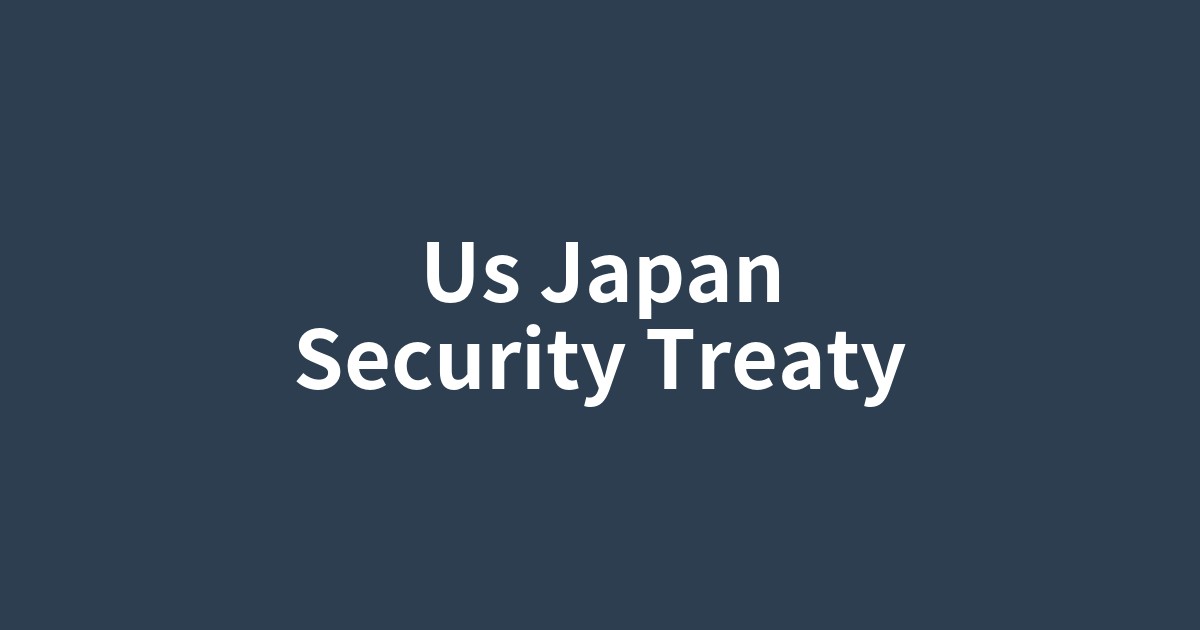このページは、歴史や文化の物語を楽しみながら、その文脈の中で重要な英単語を自然に学ぶための学習コンテンツです。各セクションの下にあるボタンで、いつでも日本語と英語を切り替えることができます。背景知識を日本語で学んだ後、英語の本文を読むことで、より深い理解と語彙力の向上を目指します。

【ご注意】
この記事には、健康、金融、法律など、読者の人生に大きな影響を与える可能性のある情報が含まれています。内容は一般的な情報提供を目的としており、専門的なアドバイスに代わるものではありません。重要な判断を下す前には、必ず資格を持つ専門家にご相談ください。
日本の防衛をアメリカに委ねる代わりに、国内に米軍基地の駐留を認める安全保障条約。その歴史的経緯と、現代に至るcontroversy(論争)。
この記事で抑えるべきポイント
- ✓日米安全保障条約は、第二次世界大戦後の日本の非軍事化と、冷戦という国際情勢の中で、日本の安全をアメリカに委ねる形で誕生したという歴史的経緯があります。
- ✓1960年の条約改定では、アメリカの日本防衛義務が明記される一方、日本側の基地提供も継続され、その是非をめぐり国内で激しい論争(安保闘争)が起きました。
- ✓条約は「抑止力」という安全保障上の利益をもたらす一方で、特に沖縄に集中する米軍基地に関連する騒音、事件、事故といった「負担」も生み出し続けているという側面があります。
- ✓冷戦終結後も、中国の台頭や北朝鮮問題など東アジアの安全保障環境の変化に対応するため、条約は日米同盟の根幹として維持・強化され、その役割は変容し続けています。
なぜ日本にはアメリカの軍事基地があるのか?
街を歩いていると、ふと疑問に思うことはないでしょうか。「なぜ日本には、アメリカの軍事基地があるのだろう?」と。その答えは、両国間で結ばれた一つの約束、『日米安全保障条約』にあります。この条約は、単なる基地の存在理由にとどまらず、戦後日本のあり方を根底から形作ってきました。本記事では、その歴史的背景から現代に至るまでの複雑な道のりを、多角的に解き明かしていきます。
Why Are There U.S. Military Bases in Japan?
Have you ever been walking down the street and wondered, "Why are there U.S. military bases in Japan?" The answer lies in a single promise made between the two nations: the U.S.-Japan Security Treaty. This treaty is not just the reason for the bases' existence; it has fundamentally shaped post-war Japan. This article will untangle its complex history, from its historical background to the present day, from multiple perspectives.
条約の誕生 ― 敗戦から冷戦の最前線へ
第二次世界大戦の敗戦を経て、日本は新たな憲法のもとで非軍事化の道を歩み始めました。しかし、国際情勢は平穏ではありませんでした。1950年に朝鮮戦争が勃発し、東アジアは共産主義と自由主義が対峙する冷戦の最前線となります。この緊迫した状況下で、日本は1951年にサンフランシスコ平和条約によって主権を回復しますが、その同じ日に旧・日米安全保障「条約(treaty)」にも署名しました。これは、独立と引き換えに、自国の「安全保障(security)」をアメリカの軍事力に委ねるという選択でした。この決断が、戦後日本の出発点となったのです。
The Birth of the Treaty: From Defeat to the Cold War Frontline
After its defeat in World War II, Japan began to walk the path of demilitarization under its new constitution. However, the international situation was not peaceful. When the Korean War broke out in 1950, East Asia became a frontline of the Cold War, pitting communism against liberalism. Amidst this tense situation, Japan regained its sovereignty with the San Francisco Peace Treaty in 1951, but on the very same day, it also signed the original U.S.-Japan Security Treaty. This was a choice to entrust the nation's security to the military power of the United States in exchange for independence. This decision became the starting point of post-war Japan.
1960年安保闘争 ― 国論を二分した条約改定
旧条約には、アメリカの日本「防衛(defense)」義務が明記されていないなど、日本にとって不平等な点が多くありました。そのため、1960年、岸信介内閣は条約の対等性を高めるための改定を目指します。新しい条約では、日本への武力攻撃に対してアメリカが共同で対処する義務が明記されました。しかし、その一方で日本がアメリカに基地を提供し続ける義務も継続されたため、国民の間で激しい反対運動、いわゆる「安保闘争」が巻き起こりました。外国軍隊の駐留が日本の「主権(sovereignty)」を侵害するのではないか、戦争に巻き込まれるのではないかという懸念が、国論を二分する大きなうねりとなったのです。
The 1960 Anpo Protests: A Treaty Revision that Divided the Nation
The original treaty had many unequal aspects for Japan, such as the lack of a clear U.S. obligation for Japan's defense. Therefore, in 1960, the cabinet of Nobusuke Kishi aimed to revise the treaty to make it more reciprocal. The new treaty stipulated that the U.S. was obligated to respond jointly to an armed attack on Japan. However, as it also continued Japan's obligation to provide bases to the U.S., fierce opposition movements, known as the "Anpo Protests," erupted among the public. Concerns that the stationing of foreign troops would infringe upon Japan's sovereignty and potentially entangle the country in war became a massive swell of opinion that divided the nation.
「抑止力」という利益と「基地」という負担
現在の日米安保条約が日本にもたらす最も大きな利益は、「抑止力(deterrence)」であると言われます。世界最強の米軍が日本に駐留することで、他国からの攻撃を未然に防ぐ効果が期待されるのです。しかし、この利益には大きな代償が伴います。それが、米軍基地がもたらす負担です。特に基地の7割以上が集中する沖縄では、騒音問題、米兵による事件・事故などが長年にわたって住民の生活を脅かしてきました。在日米軍の法的地位を定めた日米地位「協定(agreement)」のあり方も含め、基地問題は今なお続く深刻な「論争(controversy)」の火種となっています。
The Benefit of "Deterrence" and the Burden of "Bases"
It is said that the greatest benefit the current U.S.-Japan Security Treaty brings to Japan is "deterrence." The presence of the world's most powerful military in Japan is expected to prevent attacks from other countries. However, this benefit comes at a great cost: the burden of U.S. military bases. In Okinawa, where over 70% of the bases are concentrated, issues like noise pollution and incidents and accidents involving U.S. service members have threatened the lives of residents for many years. Including the nature of the U.S.-Japan Status of Forces Agreement (SOFA), which defines the legal status of U.S. forces in Japan, the base issue remains a source of serious, ongoing controversy.
冷戦後から現代へ ― 変わりゆく同盟の役割
1991年にソ連が崩壊し、冷戦は終結しました。では、なぜ日米の「同盟(alliance)」は今も維持・強化され続けているのでしょうか。その背景には、東アジアの「地政学(geopolitics)」的な環境の大きな変化があります。中国の急速な軍事力増強や、北朝鮮による核・ミサイル開発など、新たな脅威が生まれているのです。こうした状況に対応するため、日米安保条約は冷戦期の「ソ連への対抗」という役割から、「地域全体の安定」を維持するための基盤へとその役割を変容させてきました。今日においても、この条約は日本の外交・安全保障政策の根幹をなしているのです。
From the Post-Cold War Era to Today: The Evolving Role of the Alliance
The Soviet Union collapsed in 1991, bringing the Cold War to an end. Why, then, has the U.S.-Japan alliance been maintained and even strengthened? The background lies in the significant changes in the geopolitical environment of East Asia. New threats have emerged, such as China's rapid military buildup and North Korea's nuclear and missile development. To respond to these situations, the U.S.-Japan Security Treaty has transformed its role from "countering the Soviet Union" during the Cold War to serving as a foundation for maintaining "regional stability." Even today, this treaty remains the cornerstone of Japan's foreign and security policy.
結論 ― 光と影をどう見つめるか
日米安全保障条約は、戦後の日本の平和と経済的繁栄を支えた「光」の側面を持つことは間違いありません。アメリカの軍事力に守られることで、日本は経済発展に集中することができました。しかし、同時に沖縄をはじめとする基地周辺地域に重い負担を強いてきた「影」の側面もまた、紛れもない事実です。この条約に唯一の正解はありません。歴史的な経緯、安全保障上の利益、そして国民が負う負担。そのすべてを理解した上で、私たちはこの複雑な条約とどう向き合っていくべきなのか。それは、現代に生きる私たち一人ひとりに問いかけられ続けているテーマなのです。
Conclusion: How to View the Light and Shadow
There is no doubt that the U.S.-Japan Security Treaty has a "light" side, having supported Japan's post-war peace and economic prosperity. By being protected by U.S. military power, Japan was able to focus on economic development. However, the "shadow" side, which has imposed a heavy burden on base-hosting areas like Okinawa, is also an undeniable fact. There is no single correct answer to this treaty. The historical context, the security benefits, and the burden borne by the people—after understanding all of these, how should we face this complex treaty? It is a question that continues to be asked of each of us living today.